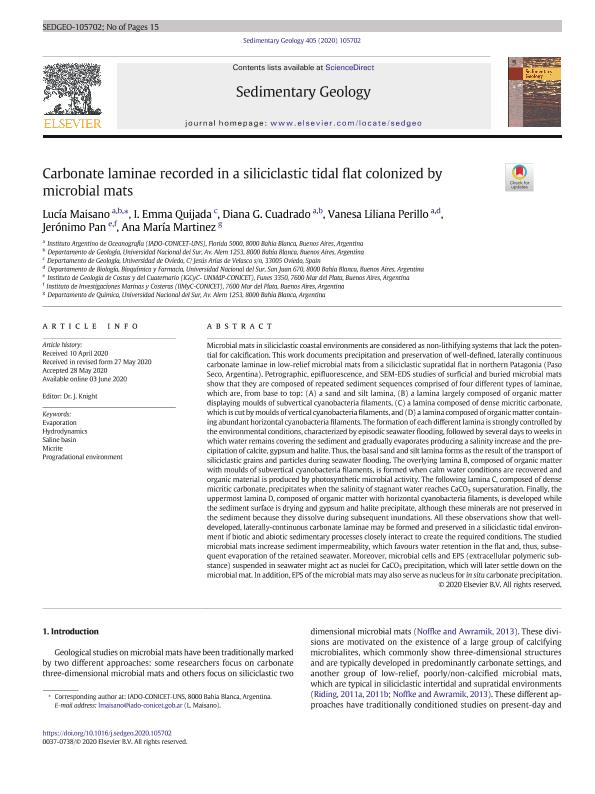Artículo
Carbonate laminae recorded in a siliciclastic tidal flat colonized by microbial mats
Maisano, Lucia ; Quijada, Isabel Emma; Cuadrado, Diana Graciela
; Quijada, Isabel Emma; Cuadrado, Diana Graciela ; Perillo, Vanesa Liliana
; Perillo, Vanesa Liliana ; Pan, Jeronimo
; Pan, Jeronimo ; Martinez, Ana María
; Martinez, Ana María
 ; Quijada, Isabel Emma; Cuadrado, Diana Graciela
; Quijada, Isabel Emma; Cuadrado, Diana Graciela ; Perillo, Vanesa Liliana
; Perillo, Vanesa Liliana ; Pan, Jeronimo
; Pan, Jeronimo ; Martinez, Ana María
; Martinez, Ana María
Fecha de publicación:
15/07/2020
Editorial:
Elsevier Science
Revista:
Sedimentary Geology
ISSN:
0037-0738
Idioma:
Inglés
Tipo de recurso:
Artículo publicado
Clasificación temática:
Resumen
Microbial mats in siliciclastic coastal environments are considered as non-lithifying systems that lack the potential for calcification. This work documents precipitation and preservation of well-defined, laterally continuous carbonate laminae in low-relief microbial mats from a siliciclastic supratidal flat in northern Patagonia (Paso Seco, Argentina). Petrographic, epifluorescence, and SEM-EDS studies of surficial and buried microbial mats show that they are composed of repeated sediment sequences comprised of four different types of laminae, which are, from base to top: (A) a sand and silt lamina, (B) a lamina largely composed of organic matter displaying moulds of subvertical cyanobacteria filaments, (C) a lamina composed of dense micritic carbonate, which is cut by moulds of vertical cyanobacteria filaments, and (D) a lamina composed of organic matter containing abundant horizontal cyanobacteria filaments. The formation of each different lamina is strongly controlled by the environmental conditions, characterized by episodic seawater flooding, followed by several days to weeks in which water remains covering the sediment and gradually evaporates producing a salinity increase and the precipitation of calcite, gypsum and halite. Thus, the basal sand and silt lamina forms as the result of the transport of siliciclastic grains and particles during seawater flooding. The overlying lamina B, composed of organic matter with moulds of subvertical cyanobacteria filaments, is formed when calm water conditions are recovered and organic material is produced by photosynthetic microbial activity. The following lamina C, composed of dense micritic carbonate, precipitates when the salinity of stagnant water reaches CaCO3 supersaturation. Finally, the uppermost lamina D, composed of organic matter with horizontal cyanobacteria filaments, is developed while the sediment surface is drying and gypsum and halite precipitate, although these minerals are not preserved in the sediment because they dissolve during subsequent inundations. All these observations show that well-developed, laterally-continuous carbonate laminae may be formed and preserved in a siliciclastic tidal environment if biotic and abiotic sedimentary processes closely interact to create the required conditions. The studied microbial mats increase sediment impermeability, which favours water retention in the flat and, thus, subsequent evaporation of the retained seawater. Moreover, microbial cells and EPS (extracellular polymeric substance) suspended in seawater might act as nuclei for CaCO3 precipitation, which will later settle down on the microbial mat. In addition, EPS of the microbial mats may also serve as nucleus for in situ carbonate precipitation.
Palabras clave:
EVAPORATION
,
HYDRODYNAMICS
,
MICRITE
,
PROGRADATIONAL ENVIRONMENT
,
SALINE BASIN
Archivos asociados
Licencia
Identificadores
Colecciones
Articulos(IADO)
Articulos de INST.ARG.DE OCEANOGRAFIA (I)
Articulos de INST.ARG.DE OCEANOGRAFIA (I)
Articulos(IIMYC)
Articulos de INSTITUTO DE INVESTIGACIONES MARINAS Y COSTERAS
Articulos de INSTITUTO DE INVESTIGACIONES MARINAS Y COSTERAS
Citación
Maisano, Lucia; Quijada, Isabel Emma; Cuadrado, Diana Graciela; Perillo, Vanesa Liliana; Pan, Jeronimo; et al.; Carbonate laminae recorded in a siliciclastic tidal flat colonized by microbial mats; Elsevier Science; Sedimentary Geology; 405; 15-7-2020; 1-15; 105702
Compartir
Altmétricas



